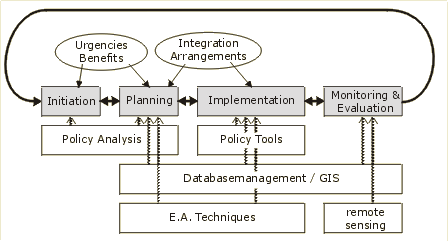|
You are here: /Conclusion
 An
overview An
overview
In this module we presented you the principles of ICZM,
i.e., the reasons why it is on the world's agenda, what
it consists of and how it could be put into practice.
The adjacent shows the issues we discussed and how they
are related. The practise component consists of the grey
shaded boxes (Initiation - Planning - Implementation -
Monitoring and Evaluation). The practise is iterative
and cyclic, hence the two headed arrows. Above it, are
the issues behind the practise. Below it are listed a
number of methods, tools and techniques to support the
process. Their position relative to shaded boxes, illustrates
when they might be useful. |
The process
The following scheme indicates how and when the matter
illustrated in this module is applied. A group of individuals,
politicians or managers realize the need for an integrated
approach to coastal management and the benefits it will
have for the users of the coastal zone. They can initiate
the process by creating a "proposal document" which will
support awareness raising among users and decision-makers.
During the planning stage, the causes of the issues at
hand are described in a "coastal profile". Based on that,
a policy must be developed to face to problem. Central
to this policy are the arrangements of institutional,
legal and financial issues to support the necessary integration
of management that will take place in the future. The
proposed policies must be evaluated for their effects;
for quick approval it must demonstrate the benefits integrated
management has relative to sectoral management. Once a
decision is taken, the program will be implemented and
continually monitored and evaluated. As more knowledge
about the coastal system becomes available, new projects,
policies, strategies, plans, programmes (or whatever)
may be initiated, or incorporated within the existing
one. |
The support
The process must be supported by a set of methods, tools
and techniques. Each of them is usable during a single,
several, or all stages described above. Note that what
is shown in the scheme, is only an indication. The scheme
is not exhaustive and the usefulness of certain methods,
tools or techniques might differ from project to project.
Policy analyses is the technique which structures strategy
development and evaluation during the first stages.
Policy tools support the implementation of ICZM based
on regulations and economical guidance.
Database management and GIS techniques are of importance
during almost the whole process. Environmental assessment
techniques must be used to evaluate the effects of the
ICZM program (Planning), or to evaluate the effects
of projects carried out within a ICZM program (Implementation).
Remote sensing techniques are useful for monitoring
spatial processes and support the evaluation of ICZM
projects.
|

|
|